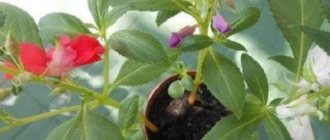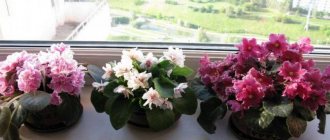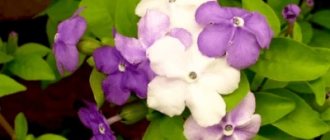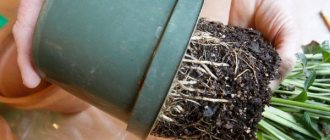Propagating azaleas is a difficult challenge even for experienced gardeners. The fact is that these ornamental shrubs grow rather slowly and often die at home. However, their extraordinary beauty during flowering pays for the effort many times over. A bright bouquet of large lily or double inflorescences that instantly attracts attention on a winter windowsill is most likely an azalea. Read on to learn how to root a cutting of such a plant to get one or more young specimens of your favorite variety.
Features of cuttings in different types of rhododendron
- In deciduous varieties, a young shoot with light-colored, partial-size leaves should be selected for rooting; the stem should bend easily, but not break. The bud at the top will be in the ripening stage. This is the growth of the last year, and it needs to be separated.
- In evergreen varieties, woody shoots are used. The leaves of the future plant should be dark-colored, of normal size, as on the mother bush, in an amount of at least five pieces.
How to determine that the shoot is ready for separation?
- Deciduous rhododendron cuttings are ready to be taken as long as they are soft in the stem and do not break.
- Evergreen varieties of rhododendron show readiness for cuttings with a dry crease of the stem. At the same time, the characteristic crunch of breaking wood is heard.
The cutting is always taken from an adult healthy plant without signs of visible external damage. Azaleas are pruned into cuttings once a year so that the mother plant has the strength to further ripen buds and flower.
Mature azalea bushes need pruning to form a beautiful and even crown, so even if it is not propagated, this is part of basic care.
Topping
When transplanting azaleas to new land, pinching is practiced to stimulate shoot growth. The bush becomes lush, overgrown with branches.
The first time the procedure is performed in winter. The primary buds of young bushes are removed for active growth of branches. Repeated pinching is done in early spring, when 5 shoots are removed.
Next, the azaleas provide care: they are placed in intense diffused light, watered regularly, allowing the water to settle, and the temperature is kept at +18 °C. After two years, the plant can be considered an adult.
The branches removed during the secondary procedure are suitable for propagation by rooting.
What soil to choose for rooting?
Here are several options for selecting soil, the main thing to remember is that only soil with a light, loose structure is suitable for rhododendrons:
- Peat is often used. If you take it from swamps, then only the very top layer, since its acidity is less.
- You can prepare a mixture of coniferous soil, peat and sand (proportion 2:1:1). For better moisture retention and loosening of the soil, Vermiculite is added.
- It is easier for beginners to buy ready-made soil for growing azaleas. It has already thought out the necessary composition and added the necessary nutrients.
- Rooted shoots are transplanted into soil similar in composition to that which was in the early stages of germination.
Reproduction of azaleas by dividing the bush
Perennial indoor rhododendrons usually consist of 3-6 trunks. Their thin fibrous roots are intertwined with each other, but if necessary they are easily separated - just wet the soil well, remove everything from the pot, and then disassemble them into individual plants with your hands or a knife. After this, each part can be planted in a small individual pot.
sposoby-razmnozheniya-azalii-22.jpg
Soil for azaleas is available in almost all flower shops. It differs from the universal mixture in its increased acidity and looser structure. But the best option is coniferous humus collected under old pine trees in the forest. It is this substrate that contains the full range of minerals and microorganisms that rhododendron plants naturally need.
kak-uhazhivat-za-azalijami-2-1.jpg
Further actions are simple - pour 3-4 cm of expanded clay or pebbles into the pots, then tamp the soil down to half the height, immerse the roots in it, trying not to injure them in the process and without deepening the base of the trunk, fill the sides with soil, and water generously. After this, the young bushes should be kept under bright, diffused light at a temperature of +16...20°C and a humidity of at least 65%, in a room with good ventilation or in the fresh air. When growing azaleas, it is extremely important not to allow the earthen ball to dry out even for a short time.
s1200.jpg
Which pot should I put it in?
Since not all rhododendron shoots can be rooted well even with careful care, experienced gardeners grow five or more young plants at a time .
In this case, a greenhouse is built. For this purpose, take a box or box and, after planting the cuttings, cover the container with film or a light-transmitting cap to maintain a comfortable temperature for the young animals of 22-25 degrees. The plants are planted at a distance of 4 cm from each other. If you manage to obtain single cuttings for planting, you can use small pots with a diameter of 5-7 cm, which will need to be covered with a transparent bag or a cut plastic bottle.
Periodically, the container with seedlings needs to be ventilated to prevent the shoots from rotting. It is also necessary to turn it towards the sunlight with the opposite side for uniform illumination.
The cuttings rooted in the box are planted in separate pots, not earlier than they have begun to grow well. The size of the individual bowl should be slightly larger than the root ball with soil. As it grows, you can transfer it to a larger pot.
Azalea is not an easy plant to propagate and requires a lot of effort and attention , so you should approach every step of cuttings responsibly!
Transfer
This procedure is required for a houseplant immediately after its acquisition, if the season provides good lighting. Transplantation is also carried out when the azalea grows and no longer fits in its container. Then after flowering it is transferred to a larger pot.
Replanting requires a pot, drainage and fresh soil.
Sequencing
The winter season is not suitable for successful transplantation. The best time is spring.
Azaleas have a very sensitive root system. Therefore, it is recommended to move it with a clod of earth. Moreover, a root feeding environment is formed in the soil, which cannot be disturbed.
First, the plant is watered. Then the pot is turned over. You need to knock on it a little so that the lump of earth comes out of the container. The bush is placed in a new container and the free space is filled with prepared fertile soil.
An azalea, propagated by one method or another, can be not only a houseplant, but also a garden one.
Step-by-step instructions: how to take cuttings at home?
Let's look step by step at how to grow rhododendron from cuttings at home and what needs to be done to propagate it.
How to separate correctly?
- Cut a cutting 10-15 cm long with a sharp, clean knife.
- Remove the three lower leaves, leaving 0.5 cm from the cutting itself. Cut the remaining leaves in half.
- On the side of the cutting, starting from the bottom, remove the bark upwards, 2 cm long. It is important not to damage the bast. This is where the roots will eventually appear.
- Before planting, treatment with a growth stimulator is necessary. The shoot should stand in the liquid solution for several hours, or better yet, overnight. When using dry, the cuttings are sprinkled with a powder mixture.
Plant (including in water)
- Spray the soil for planting with a weak solution of potassium permanganate.
- The cutting is placed in the ground to a depth of 2.5-3 cm, slightly inclined. Then compact the soil with your finger around the stem.
- The box with plantings is covered with film or a transparent cap so that the cover does not touch the plants.
Rooting in water significantly reduces the cuttings' chances of survival, because... The process of root formation itself is very long - from 3 months. It is permissible to keep the sprouts only for a few days in water with the addition of a growth stimulator. The top of the container can be covered with the cut off top of a plastic bottle to create an increased temperature.
The summer-autumn period is best suited for rooting . Sometimes winter shoots are germinated, but this is associated with a number of difficulties.
When can I expect results?
If the flower was planted 3 or 4 months ago and all planting conditions are met, then you can notice the first changes. As soon as the growth reaches 3 cm, you can remove the film from the greenhouse and plant the cuttings in separate pots, adding expanded clay to the bottom.
Do not suddenly abandon film cover. It is better to start accustoming a young azalea to changes in external conditions from one and a half hours a day, gradually increasing the time period by one hour a day.
Why do you need to plant azaleas?
When a rhododendron bush abundantly covered with red, pink or white buds appears in the house, few people think about how to properly care for it - everyone just admires the colorful petals, and from time to time water the soil in the pot with tap water. But after 2-4 weeks, the flowers and leaves begin to dry, and the owners wonder what they did wrong and how to save the azalea, which has lost its former attractiveness.
6-39-1.jpg
This problem occurs for several reasons. Initially, this is a stressful situation during transportation and sale, and then an excessively dry and warm climate in the house, associated with a lack of microelements in the store soil. As a result, the roots become thinner, dry out, and the bush dies.
e1e14c818c060b50cd6d8c15c7297275_i-3.jpg
To avoid losing the plant, it is better to do the following:
1. Immediately after purchase, transfer the roots into a pot 1.5-2 times larger in volume with the addition of special soil. Place in a cool room, water and spray regularly.
2. At the end of flowering, carefully remove dead wood and leave it like that until the end of spring, without stopping to moisturize.
3. The active growing season begins in May-June - this is the ideal time to plant the stems of the bush (if there are several of them) in separate containers, as well as trim some branches to form a compact crown.
0a711d19c009b0976820443143d16adbeee11361459b8f664c7d9065a6228a8c.jpg
This procedure will allow:
- increase the number of plants;
- rejuvenate old specimens;
- improve decorative qualities;
- obtain planting material - cuttings.
img_8374.jpg
Difficulties and problems
Often, difficulties in growing azaleas discourage inexperienced gardeners from taking cuttings of this flower again. It happens that plants die for no apparent reason in the first weeks, and sometimes they simply do not grow after the allotted time. Therefore, it is important to take into account not only the stages of planting the cutting itself, but also the following points:
- take seriously the choice of shoots, processing of tools and soil;
- assess the maturity of the plant from which the cutting is taken and make sure that its flowering period is over;
- take into account the possibility of organizing the desired temperature regime and heating the box from below if necessary;
- avoid drafts;
- for cuttings in winter, prepare additional lighting;
- constantly maintain air humidity in the greenhouse by regular spraying;
- do not allow the soil to become waterlogged when watering or dry out;
- inspect the plant for pests.
Can it be propagated by grafting?
When other methods are impossible, they resort to grafting, which helps preserve the varietal characteristics of the flower.
It is carried out during the growing season, this period occurs at the end of May - beginning of June. The rootstock (the bush to which the graft is made) must be at least 15 cm long and up to 5 years old. A shoot with an eye is used as a scion.
The procedure consists of three stages:
- Oblique cuts are made on the rootstock bark.
- The grafted cuttings are placed inside at the cutting site.
- Secure the branch with plastic wrap.
For successful grafting, ensure stable air temperature, optimal humidity conditions and moderate watering over the next 15 days.
First care for a planted houseplant
Having grown cuttings, you should not relax too much, because... the plant is still weak and requires increased care :
- It is important to regularly feed and fertilize. Remember that the bush must grow actively in the first year, otherwise it will die.
- Do not place a young plant in direct sunlight. During the winter months, it is necessary to connect additional lighting to extend daylight hours.
- Drafts and sudden temperature changes during the day and night should be avoided.
- For irrigation, you can only use settled water at room temperature. You can use rainwater or melt water.
Once a week, citric acid should be added to the water for watering azaleas (1 gram per half liter of water). The same water can be sprayed on the plant.
If a newly rooted plant soon produces buds, it is better to remove them to allow the young flower to grow stronger.
Now, knowing all the intricacies of growing azaleas, you can evaluate your strengths and capabilities. Someone will decide to practice on less demanding plants. More persistent gardeners, having created comfortable conditions for root formation and further growth and having patience, can hope that the azalea will thank for their efforts with vigorous flowering.
In any case, you should remember that a flower is like a child, the more you invest in it, the greater the likelihood of success. Cuttings are the easiest way to propagate a plant. If your attempt fails, do not despair, because next season the growing experiment can be repeated after analyzing all the errors and shortcomings.
Possible mistakes
Beginning gardeners who have never grown azaleas before often make serious mistakes. Such oversights, at best, can result in disappointment, and at worst, the death of the donor plant.
- Thus, experienced gardeners do not recommend using a flowering plant to obtain planting material. This can cause severe stress to the plant, as a result of which the bush can become seriously ill.
- For planting cuttings, you should choose loose and acidic soil. It is almost impossible to root shoots in neutral and dense soil mixtures.
- When sowing seeds, you should not cover them with substrate. Considering that this planting material is characterized by already weak germination, the hatched seedlings may not have enough strength to overcome the obstacle in the form of a layer of soil.











